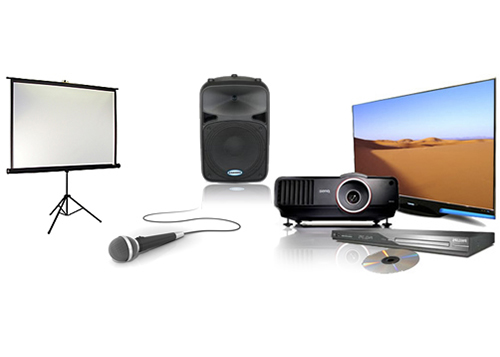Why expert audio visual charlotte nc is essential for memorable events
Comprehending the Incorporation of Audio Visual Innovation in Today's Educational Environments
The integration of audio-visual technology in educational settings has transformed the teaching and learning process. Educators currently have access to devices that provide to numerous discovering styles, boosting trainee interaction and collaboration. Nevertheless, the unification of these innovations offers both opportunities and obstacles. Understanding just how to effectively carry out these tools is crucial. What approaches can instructors employ to make the most of the benefits of audio-visual modern technology in their class?
The Evolution of Audio-Visual Modern Technology in Education And Learning
As academic requirements evolved over the decades, audio-visual innovation undertook substantial transformations that reshaped the understanding environment. Originally, tools such as movie projectors and slide programs were the primary ways of integrating aesthetic components into classrooms. These early innovations given teachers with the capacity to present information dynamically, yet they were restricted in availability and interactivity.
With the development of videotape recorder in the 1970s, class began to include recorded lessons, expanding the extent of academic resources. The introduction of personal computers in the 1980s further reinvented this landscape, allowing for the production of multimedia discussions and interactive knowing experiences.
The surge of the web in the 1990s noted a crucial minute, enabling real-time access to a riches of audio-visual products. Today, digital tools such as interactive whiteboards and on-line understanding systems remain to boost the educational experience, fostering interaction and partnership among learners.
Benefits of Audio-Visual Tools for Diverse Understanding Styles
Audio-visual tools play a crucial duty in satisfying diverse learning styles by enhancing visual discovering and enhancing auditory interaction. By integrating images, videos, and noise, these technologies produce a more comprehensive instructional setting. This multifaceted strategy enables instructors to deal with the different choices and requirements of trainees effectively.
Enhancing Visual Learning
Interaction in the discovering process is considerably boosted through making use of audio-visual tools, providing to various discovering designs. These tools, such as videos, infographics, and interactive presentations, offer visual stimulations that help understanding and retention. Aesthetic learners, specifically, gain from the unification of pictures and animations, which can streamline intricate principles and improve understanding. Furthermore, audio-visual sources can show real-world applications, making finding out more relevant and interesting. By incorporating shade, activity, and noise, instructors can develop a dynamic discovering atmosphere that catches pupils' focus and cultivates deeper cognitive connections. Inevitably, the strategic usage of audio-visual technology not only sustains visual understanding yet also enhances the general instructional experience for varied learners.
Improving Auditory Interaction
A substantial benefit of including audio-visual devices in education and learning is their capacity to enhance auditory engagement amongst pupils. These tools, which include multimedia presentations, podcasts, and interactive sound components, provide to different discovering designs, specifically benefiting acoustic learners (audio visual charlotte nc). By integrating noise and narrative, educators can create immersive experiences that record students' interest and reinforce comprehension. This engagement is vital, as it cultivates a deeper understanding of the product and advertises retention. Furthermore, audio-visual devices can assist in joint learning atmospheres, urging students to join discussions and share their insights. Ultimately, the incorporation of audio-visual technology not just supports acoustic engagement however additionally enriches the overall educational experience, making discovering more dynamic and effective for all trainees
Enhancing Involvement Through Interactive Understanding

Moreover, gamification elements, such as tests and simulations, can enhance inspiration and retention, making discovering more satisfying and reliable. These strategies not just boost cognitive involvement but additionally accommodate diverse learning designs, making sure that all students can get involved meaningfully. Therefore, interactive learning atmospheres foster a feeling of area and belonging, inevitably resulting in enhanced academic results. With the combination of audio aesthetic innovation, teachers can transform conventional class into lively areas where trainees grow and actively form their educational journeys.
Bridging Concept and Experiment Multimedia Resources
Multimedia resources serve as a crucial link in between theoretical ideas and functional application in academic setups. By boosting engagement, promoting joint learning experiences, and sustaining varied discovering designs, these tools develop a more inclusive and dynamic discovering environment - audio visual charlotte nc. This approach not just cultivates much deeper understanding yet additionally prepares trainees for real-world obstacles

Enhancing Interaction Through Multimedia
Involvement in educational setups blog substantially enhances when trainers include multimedia sources into their teaching strategies. Using video clips, podcasts, and interactive presentations boosts the learning experience, allowing pupils to link with the material on several levels. Multimedia sources deal with different discovering styles, supplying visual, auditory, and kinesthetic stimuli that can hold trainees' interest better than conventional lecture methods. look these up Additionally, these sources can simplify intricate principles, making them more available and memorable. By incorporating multimedia, instructors can develop a dynamic class environment that promotes interest and motivates students. Ultimately, the strategic usage of audio-visual technology offers to link the space in between academic knowledge and functional application, improving the academic experience for both teachers and students.
Assisting In Collaborative Knowing Knowledge
Various studies suggest that collaborative understanding experiences substantially improve student end results when integrated with multimedia sources. Multimedia tools assist in interaction among trainees, allowing them to participate in problem-solving and important thinking jointly. By utilizing video conferencing, collective platforms, and interactive presentations, teachers produce atmospheres for synergy and shared knowing. These modern technologies enable trainees to connect their ideas efficiently and obtain instant comments, fostering a much deeper understanding of the subject matter. Furthermore, multimedia resources can provide complex ideas in more digestible layouts, advertising conversation and partnership. Therefore, the combination of collaborative knowing and audio-visual technology not only enriches the educational experience but additionally prepares pupils for real-world teamwork dynamics, highlighting the value of cooperation and cumulative understanding building and construction.
Sustaining Diverse Understanding Styles
While typical teaching approaches commonly accommodate a minimal variety of finding out choices, the assimilation of audio-visual technology provides a much more inclusive method to education. By utilizing multimedia resources such as videos, interactive simulations, and digital presentations, educators can resolve different learning designs, including visual, auditory, and kinesthetic. This adaptability permits separated instruction, making it possible for trainees to engage with material in ways that reverberate with their private choices. Furthermore, audio-visual tools can assist in deeper understanding by supplying multiple depictions of complicated concepts. Consequently, pupils who may have problem with conventional approaches can discover alternative pathways to success, cultivating a more fair discovering environment that sustains scholastic achievement a fantastic read for all students.
Difficulties in Implementing Audio-Visual Modern Technology
Audio-visual modern technology holds fantastic pledge for boosting educational experiences, its application commonly encounters significant obstacles. One main issue is the financial problem related to acquiring and preserving such tools, which can stress budget plans, especially in underfunded institutions. In addition, insufficient training for instructors can prevent efficient integration, leaving them ill-prepared to utilize the modern technology totally. Technical problems, such as software breakdowns and compatibility troubles, might also disrupt lessons and irritate both teachers and students. In addition, varying degrees of trainee accessibility to modern technology outside the classroom can produce disparities in discovering possibilities. Finally, the potential for over-reliance on technology might diminish essential teaching approaches, inevitably restricting the academic experience. Attending to these difficulties needs an extensive method, including ample funding, professional growth, and fair accessibility to resources, to assure that audio-visual innovation can be leveraged efficiently in today's instructional setups.
Finest Practices for Integrating Technology in the Classroom

Additionally, promoting an interactive atmosphere with collective devices urges trainee involvement and participation. Using varied audio-visual sources accommodates various discovering styles, accommodating aesthetic, acoustic, and kinesthetic students. Routinely examining the effect of innovation on trainee discovering helps educators refine their approaches and adapt to changing demands. Ultimately, entailing pupils in the selection of technology advertises possession and inspiration. By adhering to these finest methods, teachers can create a dynamic classroom environment that successfully incorporates innovation and improves the educational experience for all students.
The Future of Audio-Visual Technology in Education And Learning
As class increasingly welcome technology, the landscape of audio-visual devices in education and learning remains to develop (audio visual charlotte nc). Future developments are anticipated to focus on greater interactivity and customization, enabling teachers to tailor finding out experiences to private student demands. Advancements such as augmented fact (AR) and online fact (VR) will likely provide immersive discovering atmospheres, enhancing student involvement and understanding
Moreover, artificial knowledge (AI) is poised to play a considerable role in audio-visual innovation by providing real-time comments and adaptive knowing paths. This combination might assist instructors recognize and deal with student difficulties a lot more effectively. Cloud-based systems will promote simpler accessibility to resources and partnership amongst students and instructors, no matter area.
Along with these technical advances, expert growth for educators will be crucial, ensuring they are outfitted to utilize these tools successfully. On the whole, the future of audio-visual technology in education guarantees to produce more dynamic, inclusive, and impactful discovering experiences.
Regularly Asked Questions
How Can Educators Pick the Right Audio-Visual Devices for Their Class?
Picking ideal audio-visual devices calls for teachers to assess their instructional objectives, consider student needs, evaluate available technology, and look for referrals from peers or specialists, ensuring devices effectively enhance learning and engagement within their specific class atmosphere.
What Budget plan Factors to consider Are There for Carrying Out Audio-Visual Innovation?
Budget plan considerations for executing audio-visual technology consist of preliminary purchase costs, maintenance expenditures, training for team, and prospective software application licensing charges. Additionally, long-term financial investment in updates and substitutes must likewise be factored into economic preparation.
Are There Particular Training Resources for Educators on Audio-Visual Equipment?
Numerous institutions supply training resources for teachers on audio-visual devices, consisting of on-line courses, workshops, and educational overviews. These resources intend to enhance instructors' abilities and self-confidence in properly incorporating modern technology right into their teaching practices.
How Do We Gauge the Performance of Audio-Visual Technology in Discovering?
Determining the performance of audio-visual innovation in discovering includes assessing student interaction, comprehension, retention rates, and total scholastic efficiency. Surveys, analyses, and empirical research studies can give beneficial insights into its effect on instructional outcomes.
What Are Usual False Impressions About Audio-Visual Innovation in Education And Learning?
Usual mistaken beliefs about audio-visual innovation in education and learning include the belief that it ensures involvement and learning end results, in addition to the presumption that all pupils profit equally, neglecting private learning preferences and demands.